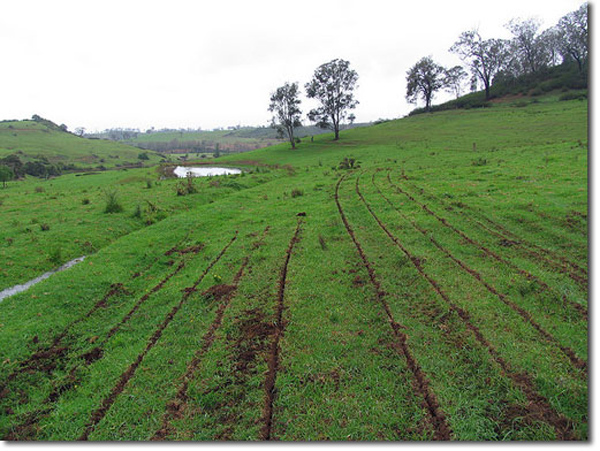
Here’s an update about the keyline cultivation system that I covered in a previous blog post titled Restoring Degraded Land. Building soil on degraded land is one of my biggest passions lately, because this is what the world needs now. Scientists say it takes nature between 100 to 1,000 years to form an inch of topsoil, depending on local conditions. The keyline system can form 4″ of good topsoil in 3 years by chiseling grooves in the ground with a simple farm implement.
From Managing Wholes.com: “The late P.A. Yeomans, developer of the Keyline system of land management, recognised that the sustainability of the whole farm was dependent on living, vibrant topsoil. The formation of new topsoil using Keyline principles, at rates not previously considered possible, was due to the use of a tillage implement designed to increase soil oxygen and moisture levels, combined with a rest/recovery form of grazing and pasture slashing, to prune grass roots and feed soil biota. Yeomans was able to produce 10 cm (4”) of friable black soil within three years, on what was previously bare weathered red shale on his North Richmond farm.”
Compare this to Biointensive gardening that claims a rate of soil building of 6” inch of topsoil in 50 years, which is 60x faster than nature. This is pretty impressive, but not nearly as fast as the keyline system. Keyline can build 66” inches of topsoil in the same time period. That’s 11 times faster than Biointensive gardening. Plus, keyline is way less labor intensive. Biointensive is based on double digging raised beds and making ex-situ compost, which are very labor intensive.
So, chiseling grooves on contour can build up 4″ of black topsoil in 3 years with keyline plowing! This is very encouraging given the sad state of the environment these days. Keyline cultivation is suitable for small plots and commercial scale farming. Note how keyline plowing is far simpler than making large swales on contour — what many permaculturists do — and that can be a costly earthworks project. Also note how he did not bring in truckloads of manure, leaves, compost, etc. The grooves on contour triggered the soil building process naturally.
You don’t need a large tractor to do this. You could use a miniature tractor like farmers use in many developing countries. This means most anyone in the developing world can do this, even in countries where the soil has been badly degraded. In summary, keyline cultivation is a fast, easy, simple way to build lots of topsoil.
Read more at the source: How to Build New Topsoil
Permaculture News.org (an excellent site by the way) has many more details about keyline cultivation

Thanks for posting this. Topsoil degradation is something I’ve been thinking about a lot, and yes anything involving lots of compost is super labour intensive. I shall give this a go by hand, unless I can find an ox;)(It’s a small plot)
You actually do want a decent sized tractor for this, because there is a lot of resistance with these chisels. The topsoil creation depends a lot on local climate and soil types. The main feature is the water infiltration, and that’s where the increased performance comes from.
That being said, it doesn’t work on all soil types, and anything with rocks, you just end up beating up your equipment. But for the areas that can use this, this is one of the cheapest and easiest ways to scale soil improvement.
Check out this ranch in Texas, that has severely degraded land and uses a combination of techniques to improve it: http://circleranchtx.com/drought-busters-restoring-desertified-desert-grasslands/
Excellent video, thanks.
I figured those small tractors could chisel one groove at a time. It all depends on the soil type and depth like you said.
OK no good for the Mediterranean then. I don’t want to even think about trying to drag a chisel through this ground, with or without a tractor.
Um, Keyline is less labour intensive because it’s done with a *tractor* rather than by hand, like a biointensive bed :)
Why would you compare a soil building technique devised for pastures + whole farm scale to a technique used for small-plot, home scale intensive vegetable production? That doesn’t seem like a useful comparison – totally different techniques for totally different contexts. Just saying :)
Good questions. For one, the ground could be chiseled by horse or oxen. You could probably rig up a homemade implement and pull it behind a motorcycle. My main point though was how keyline requires very little time, effort and resources. It’s mostly a passive approach to building soil.
Keyline can be used on smaller projects as well — say a few acres of sloping land. This is the scale that I’m envisioning for my next project — probably some type of transition forest garden.
After our forest garden is finished, I’d love to do a larger land restoration project similar to what I talked about before in the blog post titled Transition Forest Gardens. http://www.naturalbuildingblog.com/transition-forest-gardens
Right now I’m tossing around 3-4 different methods in my mind trying to figure out the best approach. I think some combination of swales, keyline, planting nutrient accumulators in the keyline grooves, ponds, sheet mulch is the most interesting.